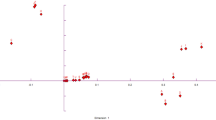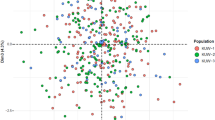Summary
Population studies were carried out on Caucasians from north-west Germany using the short tandem repeat (STR) systems HumVWA (locus: 12p12-12pter), HumMBP (locus: 18q23-pter) and HumFABP (locus: 4q28-q31). After electrophoresis 9 alleles could be identified for HumVWA in a sample size of 321 unrelated individuals and 4 alleles were found for HumFABP in 106 individuals. For HumMBP-A 10 alleles and for HumMBPB 7 alleles and I intermediate allele were determined in a sample size of 143 individuals. No deviations from Hardy-Weinberg equilibrium could be observed. In a small family study (HumVWA −n = 129; HumMBP −n = 59; HumFABP −n = 48) no new mutations could be found for HumMBP-A and HumFABP whereas 2 mutations were found in HumMBP-B and one mutation in HumVWA. Positive results could be obtained from 1 ng-20pg (HumVWA, HumFABP) and 1 ng-100pg (HumMBP) template DNA.
Zusammenfassung
Populationsstichproben nordwestdeutscher Kaukasier wurden mit den 3 Short tandem repeat (STR)-Systemen HumVWA (Locus: 12p12-12pter), HumMBP (Locus: 18823-pter) und HumFABP (Locus: 4q28-q31) untersucht. Nach gelelektrophoretischer Ruftrennung konnten 9 Allele für HumVWA in einer Bevölkerungsstichprobe von 321 nicht verwandten Personen und 4 Allele für HumFABP in einer Stichprobe von 106 Individuen differenziert werden. 10 Allele für HumMBPA und 7 Allele sowie ein Zwischenallel für HumMBP-B wurden in einer Bevölkerungsstichprobe von 143 nicht verwandten Personen gefunden. Eine Abweichung vom Hardy-Weinberg-Gleichgewicht wurde nicht festgestellt. Erste Familienstudien zeigten für HumMBP-A (Meiosen=118) und HumFABP (Meiosen = 97) keine Neumutationen, während bei HumMBP-B (Meiosen = 118) 2 Mutationen und bei HumVWA (Meiosen = 258) 1 Mutation auftraten. Die Nachweisgrenze der STR's lag im Bereich von 1 ng-20pg (HumVWA, HumFABP) bzw. 1 ng-100pg (HumMBP) template-DNA.
Similar content being viewed by others
References
Allen RC, Graves G, Budowle B (1989) Polymerase chain reaction amplification products separated on rehydratable polyacrylamide gels and stained with silver. Biotechniques 7: 736–744
Bontemps J, Houssier C, Fredericq E (1975) Physico-chemical study of the complexes of 33258 Hoechst with DNA and nucleohistone. Nucleic Acids Res 2: 971–984
Boylan KB, Ayres M, Popko B, Takahashi N, Hood LE, Prusiner SB (1990) Repetitive DNA (TGGA) 5' to the human myelin basic protein gene: a new form of oligonucleotide repetititve sequence showing length polymorphism. Genomics 6: 16–22
Brinkmann B (1993) Experiences using PCR analysis in forensic casework in Germany. Crime Lab Dig (in press)
Brinkmann B (1992) The use of STRs in stain analysis. In: Proceedings from the Third International Symposium on Human Identification. Promega Corporation, Madison, USA, pp 357–373
Brinkmann B, Rand S, Wiegand P (1991) Population and family data of RFLP's using selected single- and multi-locus systems. Int J Leg Med 104: 81–86
Budowle B, Chakraborty R, Giusti AM, Eisenberg AJ, Allen RC (1991) Analysis of the variable number of tandem repeats locus DIS80 by the polymerase chain reaction followed by high resolution polyacrylamide gel electrophoresis. Am J Hum Genet 48: 137–144
DNA recommendations -1992 Report concerning recommendations of the DNA commission of the International Society of Forensic Haemogenetics relating to the use of PCR-based polymorphisms. Int J Leg Med 104: 63–64
Du Chesne A, Rand S, Brinkmann B (1993) Spurenuntersuchungen mit DNA-Technologie — eine Retrospektivanalyse. Arch Kriminol (in press)
Edwards A, Hammond HA, ** L, Caskey CT, Chakraborty R (1992) Genetic variation at five trimeric and tetrameric tandem repeat loci in four human population groups. Genomics 12: 241–253
Kimpton CP, Walton A, Gill P (1992) A further tetranucleotide repeat polymorphism in the vWF gene. Hum Mol Gen 1: 28
Krüger J, Fuhrmann W, Lichte KH, Steffens C (1968) Zur Verwendung des Polymorphismus der sauren Erythrocytenphosphatase bei der Vaterschaftsbegutachtung. Dtsch Z Gerichtl Med 64: 127–146
Mercier B, Gaucher C, Mazurier C (1991) Characterisation of 98 alleles in 105 unrelated individuals in the F8vWF gene. Nucleic Acids Res 19: 4800
Polymeropoulos MH, **ao H, Merril CR (1992) Tetranucleotide repeat polymorphism at the human myelin basic protein gene (MBP). Hum Mol Genet 1: 658
Rand S, Puers C, Skowasch K, Wiegand P, Budowle B, Brinkmann B (192) Population genetics and forensic efficiency data of 4 AMPFLPs. Int J Leg Med 104: 329–333
Sensabaugh GF (1982) Biochemical markers of individuality. In: Saferstein R (ed) Forensic science handbook. Prentice-Hall, Englewood Cliffs, pp 340–415
Seuchter SA, Neugebauer M, Baur MP (1991) User manual for FAP, version 2.0, Institute for Medical Statistics, University of Bonn, Germany
Walsh PS, Metzger DA, Higuchi R (1991) Chelex-100 as a medium for simple extraction of DNA for PCR-based ty** from forensic material. BioTechniques 10: 506–513
Wiegand P, Schürenkamp M, Schütte U (1992) DNA extraction from mixtures of body fluids using mild preferential lysis. Int J Leg Med 104: 358–360
Wiegand P, Budowle B, Rand S, Brinkmann B (1993) Forensic validation of the STR systems SE33 and TC11. Int J Leg Med 105: 315–320
Author information
Authors and Affiliations
Rights and permissions
About this article
Cite this article
Möller, A., Wiegandl, P., Grüschow, C. et al. Population data and forensic efficiency values for the STR systems HumVWA, HumMBP and HumFABP. Int J Leg Med 106, 183–189 (1994). https://doi.org/10.1007/BF01371334
Received:
Revised:
Issue Date:
DOI: https://doi.org/10.1007/BF01371334




